key Alfa Romeo 147 2006 Owner handbook (in English)
[x] Cancel search | Manufacturer: ALFA ROMEO, Model Year: 2006, Model line: 147, Model: Alfa Romeo 147 2006Pages: 291, PDF Size: 5.52 MB
Page 17 of 291
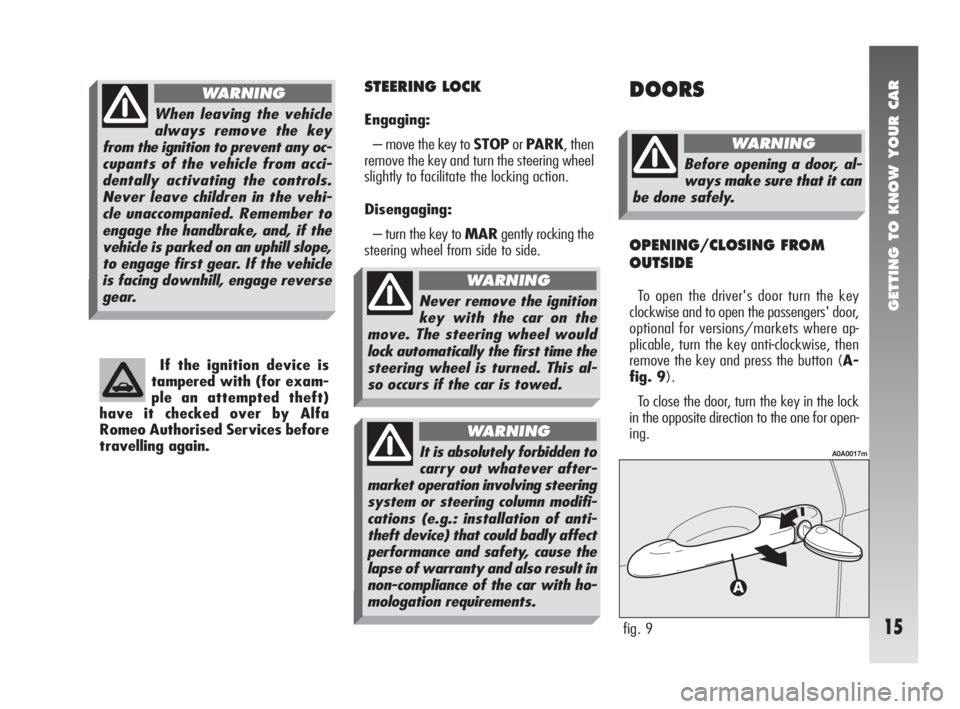
GETTING TO KNOW YOUR CAR
15
If the ignition device is
tampered with (for exam-
ple an attempted theft)
have it checked over by Alfa
Romeo Authorised Services before
travelling again.
STEERING LOCK
Engaging:
– move the key to STOPorPARK, then
remove the key and turn the steering wheel
slightly to facilitate the locking action.
Disengaging:
– turn the key to MARgently rocking the
steering wheel from side to side.
DOORS
OPENING/CLOSING FROM
OUTSIDE
To open the driver's door turn the key
clockwise and to open the passengers' door,
optional for versions/markets where ap-
plicable, turn the key anti-clockwise, then
remove the key and press the button (A-
fig. 9).
To close the door, turn the key in the lock
in the opposite direction to the one for open-
ing.
fig. 9
A0A0017m
Before opening a door, al-
ways make sure that it can
be done safely.
WARNING
Never remove the ignition
key with the car on the
move. The steering wheel would
lock automatically the first time the
steering wheel is turned. This al-
so occurs if the car is towed.
WARNING
When leaving the vehicle
always remove the key
from the ignition to prevent any oc-
cupants of the vehicle from acci-
dentally activating the controls.
Never leave children in the vehi-
cle unaccompanied. Remember to
engage the handbrake, and, if the
vehicle is parked on an uphill slope,
to engage first gear. If the vehicle
is facing downhill, engage reverse
gear.
WARNING
It is absolutely forbidden to
carry out whatever after-
market operation involving steering
system or steering column modifi-
cations (e.g.: installation of anti-
theft device) that could badly affect
performance and safety, cause the
lapse of warranty and also result in
non-compliance of the car with ho-
mologation requirements.
WARNING
Page 25 of 291
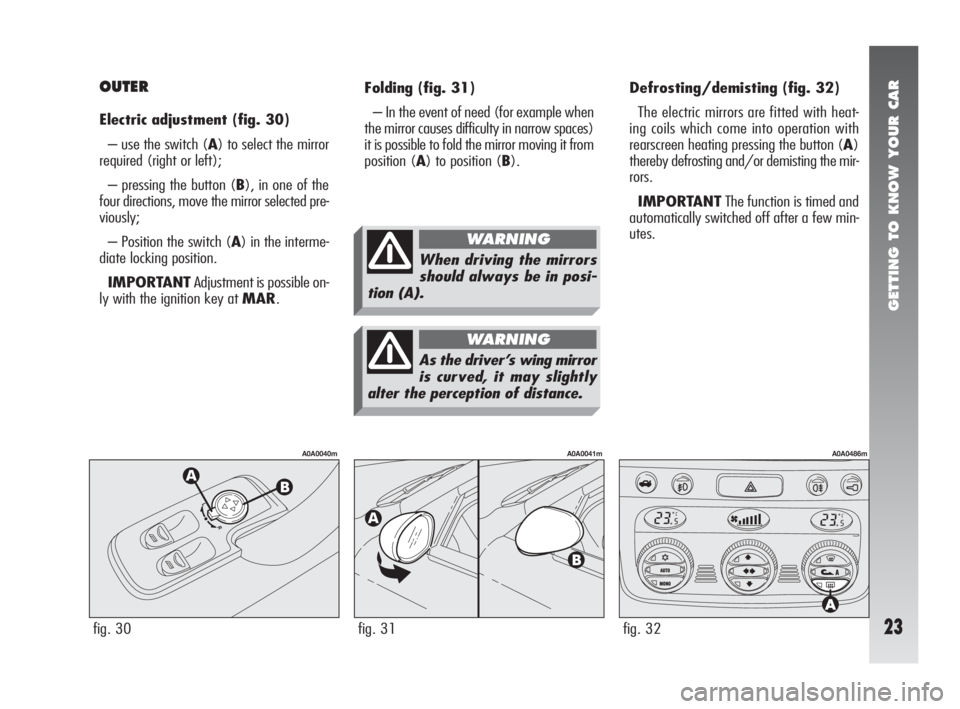
GETTING TO KNOW YOUR CAR
23
Folding(fig. 31)
– In the event of need (for example when
the mirror causes difficulty in narrow spaces)
it is possible to fold the mirror moving it from
position (A) to position (B).Defrosting/demisting(fig. 32)
The electric mirrors are fitted with heat-
ing coils which come into operation with
rearscreen heating pressing the button (A)
thereby defrosting and/or demisting the mir-
rors.
IMPORTANTThe function is timed and
automatically switched off after a few min-
utes.
fig. 31
A0A0041m
fig. 32
A0A0486m
OUTER
Electric adjustment (fig. 30)
– use the switch (A) to select the mirror
required (right or left);
– pressing the button (B), in one of the
four directions, move the mirror selected pre-
viously;
– Position the switch (A) in the interme-
diate locking position.
IMPORTANTAdjustment is possible on-
ly with the ignition key at MAR.
fig. 30
A0A0040m
When driving the mirrors
should always be in posi-
tion (A).
WARNING
As the driver’s wing mirror
is curved, it may slightly
alter the perception of distance.
WARNING
Page 26 of 291
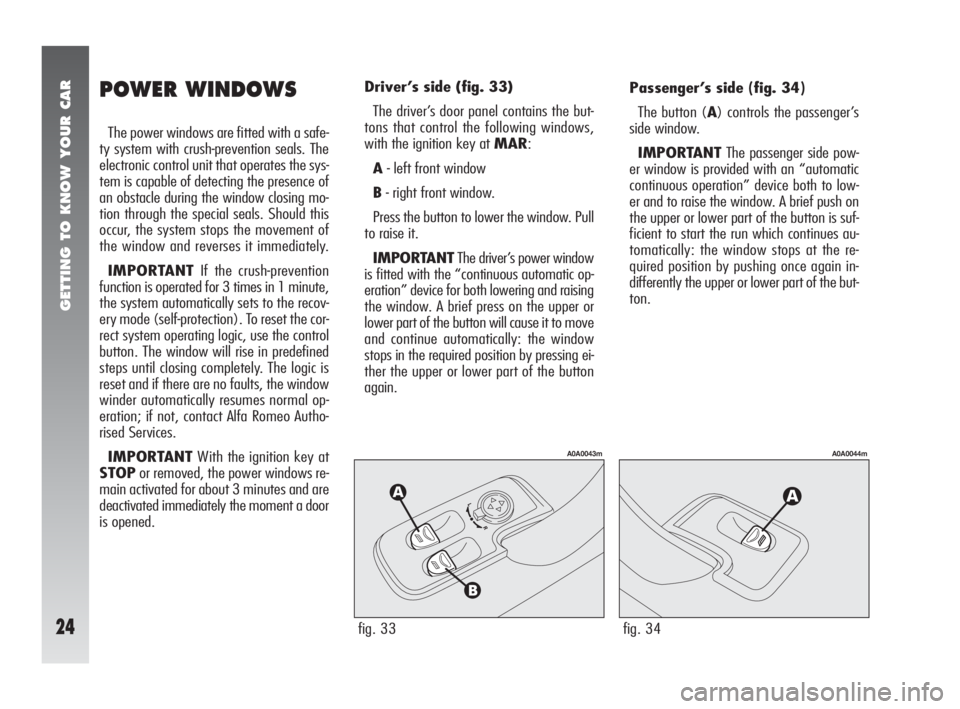
GETTING TO KNOW YOUR CAR
24
POWER WINDOWS
The power windows are fitted with a safe-
ty system with crush-prevention seals. The
electronic control unit that operates the sys-
tem is capable of detecting the presence of
an obstacle during the window closing mo-
tion through the special seals. Should this
occur, the system stops the movement of
the window and reverses it immediately.
IMPORTANTIf the crush-prevention
function is operated for 3 times in 1 minute,
the system automatically sets to the recov-
ery mode (self-protection). To reset the cor-
rect system operating logic, use the control
button. The window will rise in predefined
steps until closing completely. The logic is
reset and if there are no faults, the window
winder automatically resumes normal op-
eration; if not, contact Alfa Romeo Autho-
rised Services.
IMPORTANTWith the ignition key at
STOPor removed, the power windows re-
main activated for about 3 minutes and are
deactivated immediately the moment a door
is opened.
fig. 33
A0A0043m
fig. 34
A0A0044m
Passenger’s side (fig. 34)
The button (A) controls the passenger’s
side window.
IMPORTANTThe passenger side pow-
er window is provided with an “automatic
continuous operation” device both to low-
er and to raise the window. A brief push on
the upper or lower part of the button is suf-
ficient to start the run which continues au-
tomatically: the window stops at the re-
quired position by pushing once again in-
differently the upper or lower part of the but-
ton. Driver’s side (fig. 33)
The driver’s door panel contains the but-
tons that control the following windows,
with the ignition key at MAR:
A- left front window
B- right front window.
Press the button to lower the window. Pull
to raise it.
IMPORTANTThe driver’s power window
is fitted with the “continuous automatic op-
eration” device for both lowering and raising
the window. A brief press on the upper or
lower part of the button will cause it to move
and continue automatically: the window
stops in the required position by pressing ei-
ther the upper or lower part of the button
again.
Page 27 of 291
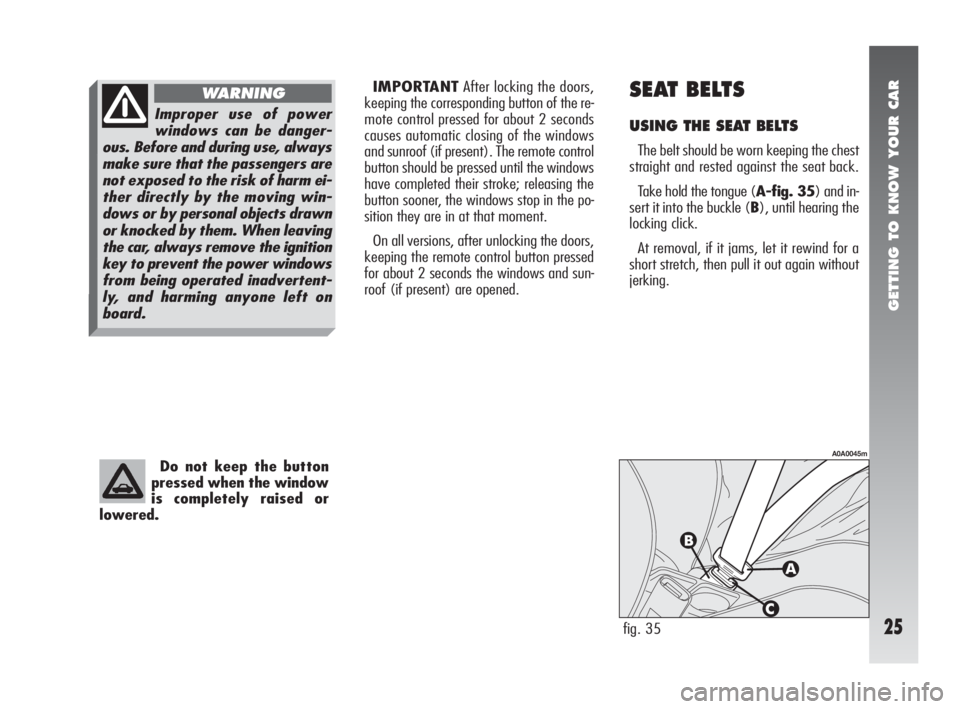
GETTING TO KNOW YOUR CAR
25
Do not keep the button
pressed when the window
is completely raised or
lowered.
IMPORTANTAfter locking the doors,
keeping the corresponding button of the re-
mote control pressed for about 2 seconds
causes automatic closing of the windows
and sunroof (if present). The remote control
button should be pressed until the windows
have completed their stroke; releasing the
button sooner, the windows stop in the po-
sition they are in at that moment.
On all versions, after unlocking the doors,
keeping the remote control button pressed
for about 2 seconds the windows and sun-
roof (if present) are opened.SEAT BELTS
USING THE SEAT BELTS
The belt should be worn keeping the chest
straight and rested against the seat back.
Take hold the tongue (A-fig. 35) and in-
sert it into the buckle (B), until hearing the
locking click.
At removal, if it jams, let it rewind for a
short stretch, then pull it out again without
jerking.
fig. 35
A0A0045m
Improper use of power
windows can be danger-
ous. Before and during use, always
make sure that the passengers are
not exposed to the risk of harm ei-
ther directly by the moving win-
dows or by personal objects drawn
or knocked by them. When leaving
the car, always remove the ignition
key to prevent the power windows
from being operated inadvertent-
ly, and harming anyone left on
board.
WARNING
Page 36 of 291
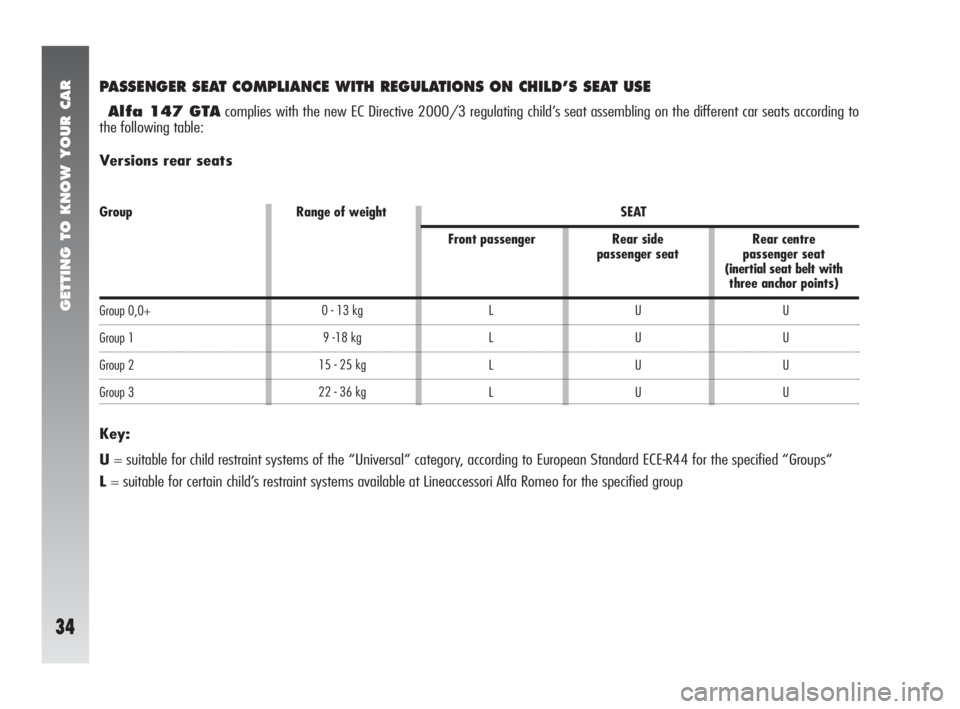
GETTING TO KNOW YOUR CAR
34
PASSENGER SEAT COMPLIANCE WITH REGULATIONS ON CHILD’S SEAT USE
Alfa 147 GTAcomplies with the new EC Directive 2000/3 regulating child’s seat assembling on the different car seats according to
the following table:
Versions rear seats
U
U
U
U U
U
U
U L
L
L
L 0 - 13 kg
9 -18 kg
15 - 25 kg
22 - 36 kg
Group Range of weight SEAT
Front passenger Rear side Rear centre
passenger seat passenger seat
(inertial seat belt with
three anchor points)
Group 0,0+
Group 1
Group 2
Group 3
Key:
U= suitable for child restraint systems of the “Universal“ category, according to European Standard ECE-R44 for the specified “Groups“
L= suitable for certain child’s restraint systems available at Lineaccessori Alfa Romeo for the specified group
Page 39 of 291
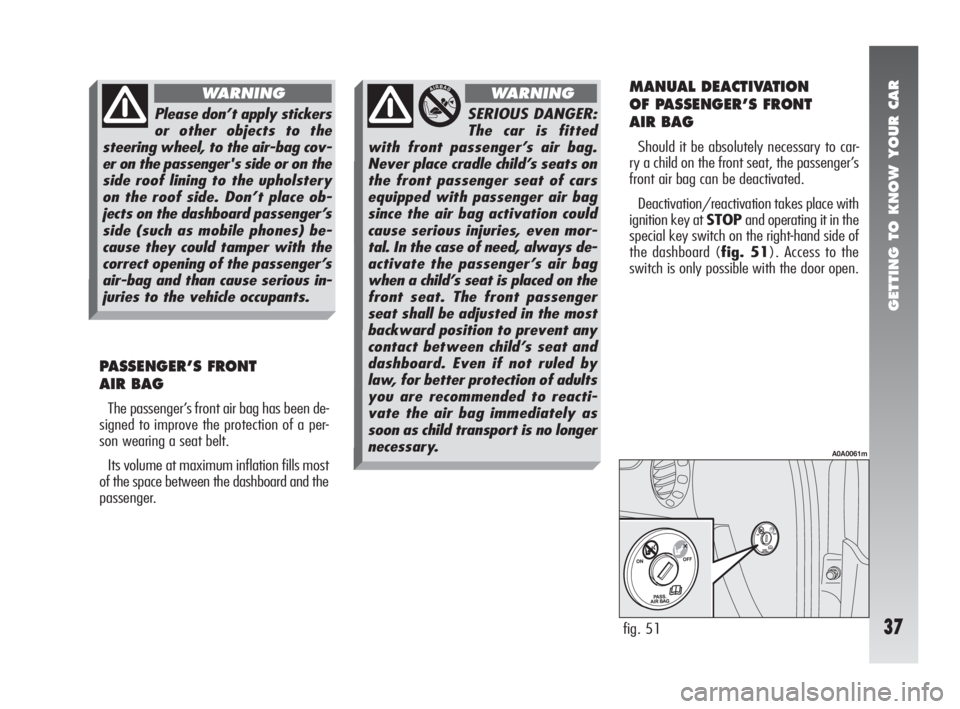
GETTING TO KNOW YOUR CAR
37
PASSENGER’S FRONT
AIR BAG
The passenger’s front air bag has been de-
signed to improve the protection of a per-
son wearing a seat belt.
Its volume at maximum inflation fills most
of the space between the dashboard and the
passenger.
MANUAL DEACTIVATION
OF PASSENGER’S FRONT
AIR BAG
Should it be absolutely necessary to car-
ry a child on the front seat, the passenger’s
front air bag can be deactivated.
Deactivation/reactivation takes place with
ignition key at STOPand operating it in the
special key switch on the right-hand side of
the dashboard (fig. 51). Access to the
switch is only possible with the door open.
fig. 51
A0A0061m
SERIOUS DANGER:
The car is fitted
with front passenger’s air bag.
Never place cradle child’s seats on
the front passenger seat of cars
equipped with passenger air bag
since the air bag activation could
cause serious injuries, even mor-
tal. In the case of need, always de-
activate the passenger’s air bag
when a child’s seat is placed on the
front seat. The front passenger
seat shall be adjusted in the most
backward position to prevent any
contact between child’s seat and
dashboard. Even if not ruled by
law, for better protection of adults
you are recommended to reacti-
vate the air bag immediately as
soon as child transport is no longer
necessary.
WARNING
Please don’t apply stickers
or other objects to the
steering wheel, to the air-bag cov-
er on the passenger's side or on the
side roof lining to the upholstery
on the roof side. Don’t place ob-
jects on the dashboard passenger’s
side (such as mobile phones) be-
cause they could tamper with the
correct opening of the passenger’s
air-bag and than cause serious in-
juries to the vehicle occupants.
WARNING
Page 40 of 291

GETTING TO KNOW YOUR CAR
38
The key-operated switch (fig. 51) has
two positions:
1) Passenger’s front Air bag activated:
(ONposition
P) warning light on instru-
ment cluster off; it is absolutely prohibited
to carry a child on the front seat.
2) Passenger’s front Air bag deactivated:
(OFFposition
F) warning light on in-
strument cluster on; it is possible to carry a
child protected by special restraint systems
on the front seat.
The warning light
Fon the cluster stays
on permanently until the passenger’s Air bag
is reactivated.
Deactivation of the passenger’s front Air
bag does not inhibit operation of the side Air
bag.
When the door is open, the key can be
inserted and removed in both positions.
SIDE AIR BAGS
(SIDE BAG - WINDOW BAG)
The side bag and window bag have the
task of increasing protection of the occu-
pants in the event of a side crash of medi-
um-high severity.
They are formed of an instantaneously-in-
flating cushion:
– the side bag is housed in the back rest
of the front seats; with this solution it is al-
ways possible to have the cushion in the op-
timum position in relation to the passenger,
regardless of the adjustment of the seat;
– the window bags, which are “curtain“
cushions, are housed in the side roof lining
covered by a special trim, which makes it
possible to extend the cushion downwards.
This solution, designed to protect the head,
makes it possible to offer the highest degree
of protection to the front and rear occupants
in the event of side crash, thanks to the wide
cushion inflation surface.
In the event of a side crash, an electronic
control unit processes the signals leading
from a deceleration sensor and activates,
when necessary, inflation of the bags.The bags inflate instantaneously, setting
themselves between the body of the front
passengers and the car door. The bags de-
flate immediately afterwards.
In the event of minor side crashes (for
which the restraining action of the seat belts
is sufficient), the air bags are not deployed.
Also in this case it is of vital importance to
wear the seat belts since in case of side
crash they guarantee proper positioning of
the occupant and prevent the occupant to
be pitched out of the car in case of violent
crashes.
Therefore the side air bags do not replace
but are complementary to the use of belts,
which you are recommended to always
wear, as specified by law in Europe and most
non-European countries.
Operation of the side air bags and window
bags is not disabled by the front air bag de-
activation switch, as described in the previ-
ous paragraphs.
Use the switch only with
the engine off and the ig-
nition key removed.
WARNING
Page 42 of 291

GETTING TO KNOW YOUR CAR
40
GENERAL CAUTIONS
You are reminded that
when the ignition key is
engaged and in the MAR position,
the Air bags can be triggered also
on a stationary vehicle, if it is
bumped by another moving vehi-
cle. Therefore, even with the car
stationary, never allow children on
the front seat. You are also re-
minded that with the car station-
ary, without the key engaged and
turned, the Air bags are not trig-
gered in the event of an impact; in
this case the failure to trigger the
air bags should not be considered
a system failure.
WARNING
Do not cover the back rest
of front seats with trims or
covers there are not set for the use
of side bags.
WARNING
If the ¬warning light does
not turn on when turning the
ignition key to MAR or if it stays on
when travelling, this could indicate a
failure in safety retaining systems; un-
der this condition air bags or preten-
sioners could not trigger in the event
of collision or, in a restricted number
of cases, they could trigger acciden-
tally. Stop the car contact Alfa Romeo
Authorised Services to have the sys-
tem checked immediately.
WARNING
Never travel with objects
on your lap, in front of the
chest or with a pipe, pencil, etc. be-
tween your lips. Serious injury may
result in the case of the air bag be-
ing triggered.
WARNING
If the car has been stolen
or an attempt to steal it
has been made, if it has been sub-
jected to vandals or floods, have
the Air bag system checked by Al-
fa Romeo Authorized Services.
WARNING
Always keep your hands
on the steering wheel rim
when driving, so that if the Air bag
is triggered, it can inflate without
meeting any obstacles. Do not dri-
ve with the body bent forwards,
keep the seat back rest in the erect
position and lean your back well
against it.
WARNING
Please don’t apply stickers
or other objects to the
steering wheel, to the air-bag cov-
er on the passenger's side or on the
side roof lining to the upholstery
on the roof side. Don’t place ob-
jects on the dashboard passenger’s
side (such as mobile phones) be-
cause they could tamper with the
correct opening of the passenger’s
air-bag and than cause serious in-
juries to the vehicle occupants.
WARNING
Page 43 of 291
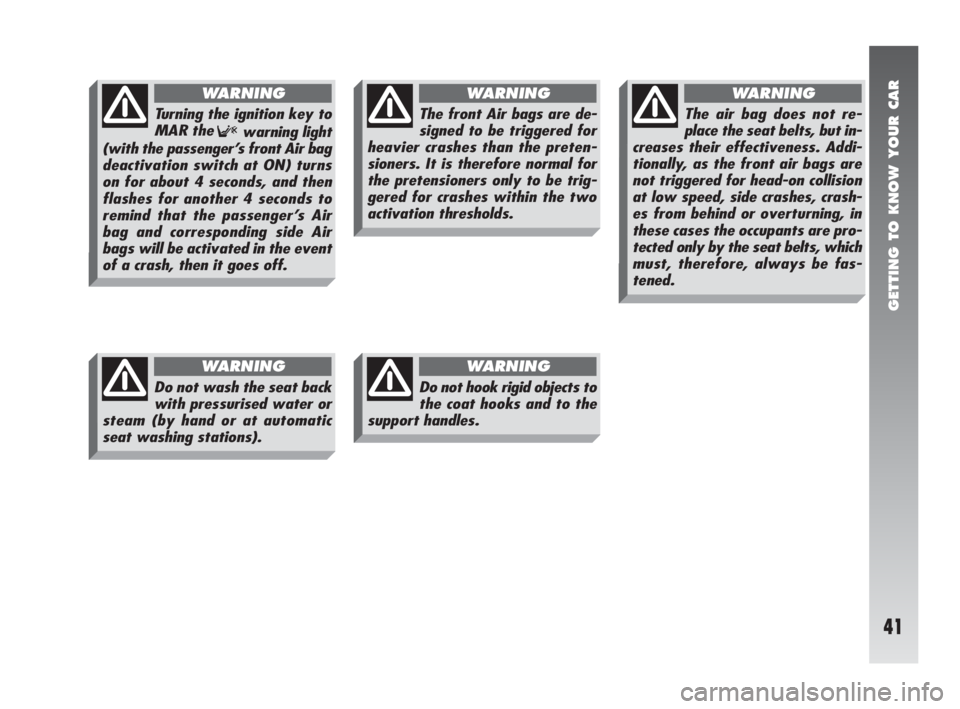
GETTING TO KNOW YOUR CAR
41
Turning the ignition key to
MAR the
Fwarning light
(with the passenger’s front Air bag
deactivation switch at ON) turns
on for about 4 seconds, and then
flashes for another 4 seconds to
remind that the passenger’s Air
bag and corresponding side Air
bags will be activated in the event
of a crash, then it goes off.
WARNING
Do not hook rigid objects to
the coat hooks and to the
support handles.
WARNING
Do not wash the seat back
with pressurised water or
steam (by hand or at automatic
seat washing stations).
WARNING
The front Air bags are de-
signed to be triggered for
heavier crashes than the preten-
sioners. It is therefore normal for
the pretensioners only to be trig-
gered for crashes within the two
activation thresholds.
WARNING
The air bag does not re-
place the seat belts, but in-
creases their effectiveness. Addi-
tionally, as the front air bags are
not triggered for head-on collision
at low speed, side crashes, crash-
es from behind or overturning, in
these cases the occupants are pro-
tected only by the seat belts, which
must, therefore, always be fas-
tened.
WARNING
Page 44 of 291
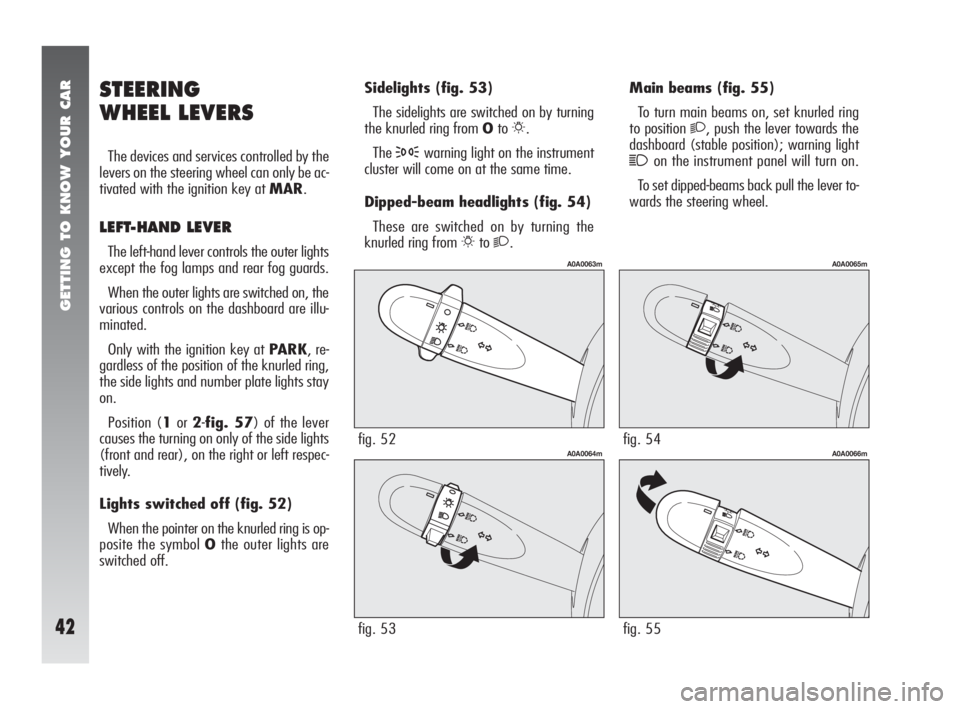
GETTING TO KNOW YOUR CAR
42
STEERING
WHEEL LEVERS
The devices and services controlled by the
levers on the steering wheel can only be ac-
tivated with the ignition key at MAR.
LEFT-HAND LEVER
The left-hand lever controls the outer lights
except the fog lamps and rear fog guards.
When the outer lights are switched on, the
various controls on the dashboard are illu-
minated.
Only with the ignition key at PARK, re-
gardless of the position of the knurled ring,
the side lights and number plate lights stay
on.
Position (1or2-fig. 57) of the lever
causes the turning on only of the side lights
(front and rear), on the right or left respec-
tively.
Lights switched off (fig. 52)
When the pointer on the knurled ring is op-
posite the symbol Othe outer lights are
switched off.Sidelights(fig. 53)
The sidelights are switched on by turning
the knurled ring from Oto
6.
The
3warning light on the instrument
cluster will come on at the same time.
Dipped-beam headlights (fig. 54)
These are switched on by turning the
knurled ring from
6to2.
fig. 52
A0A0063m
fig. 53
A0A0064m
Main beams (fig. 55)
To turn main beams on, set knurled ring
to position
2, push the lever towards the
dashboard (stable position); warning light
1on the instrument panel will turn on.
To set dipped-beams back pull the lever to-
wards the steering wheel.
fig. 54
A0A0065m
fig. 55
A0A0066m